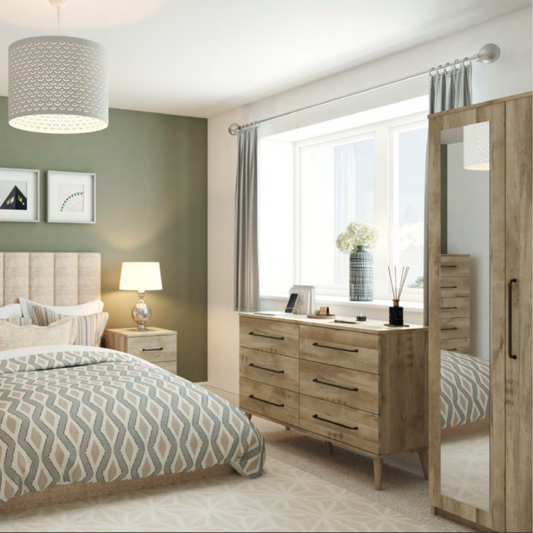
The Ultimate Guide to Bed Sizes in the UK
Share
Whether you’re redecorating your space, upgrading your bed, or furnishing a guest room, the size of your bed not only impacts comfort but also how the room functions overall. With several options to choose from, understanding the different bed sizes available in the UK and how they suit various needs is essential.
Single Bed (90 x 190 cm)
A Single Bed, measuring 90 x 190 cm, is the smallest standard bed size available in the UK. It’s ideal for children, teenagers, and guest rooms. A single bed offers just enough space for one person to sleep comfortably, and its compact size makes it a popular choice for smaller bedrooms or multifunctional spaces.
Single beds are often used in:
- Children’s bedrooms: A single bed is perfect for younger children transitioning from a toddler bed. It offers enough space for a comfortable night’s sleep without taking up too much room for play areas or other furniture.
- Teenagers’ rooms: As children grow, a single bed continues to be a great option. It’s large enough to accommodate most teenagers, and its compact size ensures that there is still room for desks, bookshelves, or other essential furniture.
- Guest rooms: In spare rooms where space is limited, a single bed can provide a comfortable sleeping area for overnight visitors. Many guest rooms are designed to be multifunctional, doubling as home offices or storage areas, so a single bed allows you to optimize the space without compromising on comfort.
Double Bed (135 x 190 cm)
The Double Bed, measuring 135 x 190 cm, is one of the most common bed sizes in the UK. While it’s often considered the standard for two people, it can also be an excellent choice for single sleepers who like a little extra room.
A double bed can be a perfect fit for:
- Couples with limited bedroom space: For smaller master bedrooms, a double bed offers enough room for two people to sleep, albeit without as much space to spread out as a larger bed would provide. However, it is a great space-saving solution for those with smaller homes.
- Solo sleepers who enjoy extra space: Many single sleepers prefer a double bed for the added comfort and space it provides, especially if they toss and turn during the night.
King Bed (150 x 200 cm)
The King Bed, measuring 150 x 200 cm, is a popular choice for couples who want more sleeping space. Its larger dimensions offer more comfort, making it ideal for master bedrooms with ample space.
Why a King Bed Is a Popular Choice
- Ample sleeping space: A king-size bed provides enough room for two people to sleep comfortably without disturbing each other. It’s particularly useful for couples where one or both partners move around a lot during the night.
- Better for taller individuals: The extra length (200 cm) of a king-size bed makes it a better option for taller people who find smaller beds too short.
Super King Bed (180 x 200 cm)
The Super King Bed, measuring 180 x 200 cm, is the largest standard bed size available in the UK. It’s the ultimate in luxury, offering an expansive sleeping space perfect for couples who prioritize comfort or for anyone who simply wants the best in bedroom furniture.
Benefits of a Super King Bed
- Luxurious space: A super king bed provides ample room for two people to stretch out and sleep without feeling crowded. It’s ideal for couples who want extra space to sleep comfortably or for families who often have kids or pets joining them in bed.
- Enhanced comfort: The large size of a super king bed contributes to better sleep quality, as both partners can move freely without disturbing each other. This makes it particularly beneficial for light sleepers.
Choosing the Right Size for Your Space
When selecting a bed, it’s crucial to ensure that it fits well within your bedroom while leaving enough space for movement and other furniture. Here’s a step-by-step guide to help you choose the right bed size:
- Measure Your Bedroom
Before purchasing a bed, measure the dimensions of your bedroom, noting the length, width, and height of the space. Don’t forget to account for any architectural features like windows, radiators, or doors that might impact furniture placement.
- Consider Room Layout
Think about how you’ll arrange other furniture around the bed. Ensure there’s enough space to open wardrobe doors, pull out drawers, and move around comfortably. Ideally, leave at least 60 cm of clearance around the bed to ensure ease of movement.
- Choose Furniture Proportional to the Bed
Larger beds require proportional furniture to maintain balance. For example, if you’re opting for a super king bed, choose wider bedside tables and larger wardrobes to ensure that the room doesn’t feel dominated by the bed.
- Account for Your Lifestyle
Consider how you use your bedroom. If it’s simply a space to sleep, you might prioritize a larger bed over additional furniture. However, if your bedroom doubles as a workspace or reading nook, you may need to select a smaller bed to accommodate other furniture.
Choosing the right bed size is about more than just comfort—it’s about ensuring that your bedroom functions well as a whole. By taking into consideration the size of your room, your personal preferences, and how you use the space, you can select a bed that enhances both your comfort and the overall design of your bedroom.





